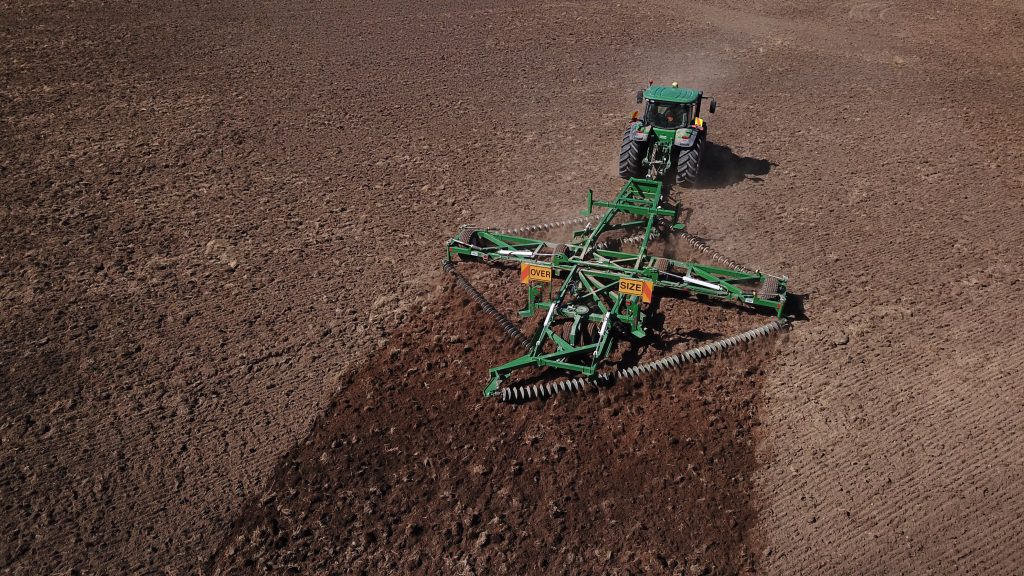The farming practice of tillage has been adopted by farmers for centuries. In its early days, tillage relied on manual labour, with workers pulling ploughs or utilising animals to trample the soil.
Presently, machinery is employed to achieve the same objective of cultivating and preparing the soil.
What is Tillage
Tillage is an important farming practice that assists in readying the soil for optimal plant growth. It can be accomplished using various tools such as tractors, harrows, or disc ploughs.
The primary purpose of tillage is to flip the soil surface, break down soil clumps, and remove unwanted weeds and debris.
This process also aids in enhancing the accessibility of rainwater or irrigation to the plant’s root zone, thereby promoting its nourishment.
Tillage involves the mechanical manipulation of the top layer of soil, intending to bring about targeted enhancements in the physical, chemical, and biological characteristics of the soil.
This practice plays a crucial role in facilitating ideal seed germination, fostering strong growth of plant seedlings, and stimulating overall crop development.
Tillage Types
Preparatory Tillage
- Preparatory tillage refers to the initial soil cultivation procedures carried out before primary tillage.
- Its purpose is to prepare the soil for further cultivation by utilising lighter and shallower techniques, typically employing implements such as harrows.
- Preparatory tillage serves to eliminate weeds, incorporate crop residues, and create a uniform soil surface, ensuring optimal conditions for subsequent tillage activities.
- It can also be called pre-harvest tillage and involves both primary and secondary tillage.
Primary Tillage
- Primary tillage represents the more extensive and deep soil cultivation carried out after preparatory tillage.
- It involves the utilisation of heavy-duty implements like moldboard ploughs, chisel ploughs, or deep tillers to thoroughly disturb the soil.
- The primary tillage operations are designed to break up compacted layers, incorporate organic matter, and improve the overall soil structure.
- It is often performed at greater depths for reaching the subsoil layers.
Secondary Tillage
- Minimum tillage refers to the additional tillage operations carried out after primary tillage.
- It takes place following the initial soil preparation and typically involves the use of lighter and shallower cultivation methods.
- The purpose of secondary tillage is to further refine the soil surface, enhance seedbed preparation, and deal with any remaining weeds or soil clumps.
- Implements such as disc harrows and cultivators, are commonly employed in secondary tillage.
- The ultimate objective of secondary tillage is to establish an optimal environment for seed germination, foster healthy root development, and facilitate the overall establishment of the crop.
Reduced Tillage
- Reduced tillage is a farming practice that focuses on minimising soil disturbance by decreasing the frequency, depth, or extent of tilling in fields.
- It is a part of conservation tillage. Conservation tillage is a farming system designed to preserve and protect soil, water, and energy resources by minimising the intensity of tillage operations and preserving crop residue.
- By implementing reduced tillage techniques, farmers aim to promote soil conservation and improve the sustainability of farming practices.
Implementing reduced tillage can be achieved through various methods. Here are some commonly used approaches:
- Strip-Till
- No-Till
- Ride Tillage
Intensive Tillage
- Intensive tillage refers to a traditional farming method characterised by extensive and frequent mechanical soil disturbance.
- It mainly involves ploughing, and thorough soil overturning before planting or between crop cycles.
- Intensive tillage aims to create an ideal seedbed for optimal seed germination, weed control, and nutrient incorporation.
Tillage Wisdom: Farmers Make Informed Choices, As Pitfalls Of Intensive Tillage Are Highlighted Below:
- Soil Erosion
- Increased Nutrient Runoff
- Reduced Soil Organic Matter
- Increased Green House Gas Emissions
Zone Tillage
- Zone tillage is a farming practice characterised by the targeted tilling of particular zones or strips of land within a field while leaving the rest of the area either untilled or minimally disturbed.
- It seeks to strike a balance between cultivating the necessary areas and maintaining the unity of the surrounding soil.
To deepen your understanding, please read Different Types of Tillage Systems.
Tillage Equipments
Introducing the Kelly Tillage system, the true workhorse of the farm that never rests. From dawn to dusk, it’s your trusted companion for all farming tasks.
Each of its products serves as the best tillage equipment, flawlessly covering tasks from preparing a fine seedbed to harvest and even the post-harvest functions.
Calling all farmers!
- Model 2006 of Kelly Tillage is used for tilling the soil. Its offset diamond chain layout, hydraulic chain tensioning, and floating wings allow it to effectively till the soil and achieve a level cut, even on undulating terrain.
- The shallow-working Disc Chains of Model 1204 gently glide over the soil surface, effectively smoothing the topsoil for harvest while simultaneously eliminating weeds without disrupting the root zone.
Weed-Wipeout With Kelly Tillage Equipment
- Using the sharp edge of the K4 Disc, farmers can easily pull out weeds from the soil. The disc flips the weeds over and leaves them on the surface, where they eventually die.
- The CL1 Disc Chain is an ideal tool for farmers to level their soil effectively. Not only does it help them achieve a smooth and even surface, but it also plays a crucial role in preserving precious moisture and maintaining soil health.
Goals Of Tillage
- To prevent the wearing away, deterioration, and loss of soil.
- Modifies the heat-holding ability of the soil.
- Increases soil aeration.
- To make the farm surface suitable for smooth and consistent distribution of irrigation and drainage water.
- To mix crop residues, green manure, and other organic fertilisers into the soil.
- To redistribute the various components of the soil, such as soil particles, organic matter, microorganisms, moisture, and air, in a more even and balanced manner.
- To speed up the breaking down and wearing away of soil over time.
- When the soil is tilled, it becomes less compacted, making it easier for roots to push through and establish themselves.
- Tilling the soil disrupts the habitats and homes of the pests, making it more difficult for them to survive and cause harm to plants.
Tillage and its Impact on Soil Quality!
Recent studies have revealed that those farmers who solely depend on deep tillage as a means to enrich the soil with nutrients, might not achieve the desired goals.
They should strongly consider adopting shallow tillage practices after deep tillage for the sake of soil conservation due to the numerous benefits it offers as mentioned below:
- Firstly, it effectively controls weeds by disrupting their growth and limiting their access to light.
- Secondly, it improves soil aeration, allowing for better oxygen flow and promoting healthy root development.
- Additionally, shallow tillage enhances water infiltration, reducing surface runoff and improving the soil’s ability to retain moisture.
These advantages contribute to improved crop establishment, increased yields, and overall enhanced soil health, making shallow tillage a valuable practice for farmers.
Say hello to the fruitful harvest!
Farmers, pay attention! Kelly Tillage has the transformative solution you’ve been waiting for. Get your hands on their innovative shallow/light tillage equipment. Now preserve your soil health with ease.
Conclusion
To sum it up, this comprehensive guide to tillage is a worthy resource for farmers and farming enthusiasts. By exploring a wide range of tillage equipment, comprehending their objectives, and knowing tillage objectives, readers acquire a detailed understanding of soil management.
With the insights revealed in this guide, individuals can optimise their farming practices, promote sustainable farming, and achieve exceptional results in their fields.


